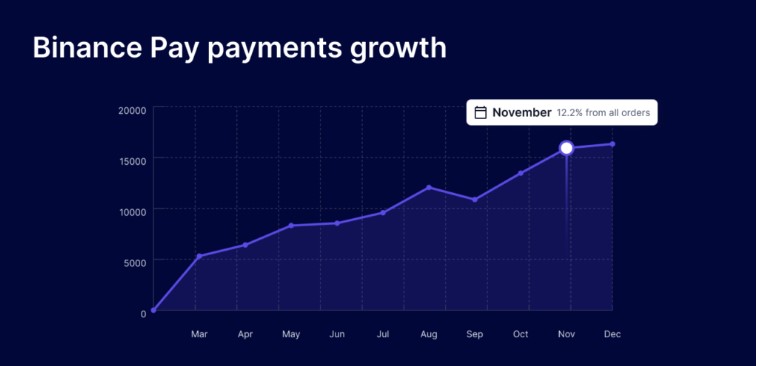The year 2023 witnessed a remarkable surge in crypto payments, signaling a significant milestone in adopting digital currencies for retail and e-commerce transactions.
According to a recent report by CoinGate, a crypto payment processor firm, the number of crypto payments processed reached staggering heights, showcasing robust growth and diversification in the crypto landscape.
Massive Surge In Crypto Payments
In 2023, CoinGate processed an astounding 1,294,058 cryptocurrency payments, marking a 39.4% increase compared to the previous record. This exponential growth, equivalent to one payment every 24 seconds, underscores the accelerating pace of crypto adoption.
Notably, approximately one-third (32.35%) of all transactions processed by CoinGate in the last ten years occurred in 2023, emphasizing the surge in the popularity of digital currencies.
Per the report, integrating Binance Pay wallet into CoinGate’s payment services in March 2023 played a significant role in driving this growth.

Binance Pay accounted for 8.2% of all crypto payments in 2023, showcasing a steady increase in usage throughout the year. This upward trend, from 4.5% in March to 13% in December, indicates the growing adoption and usage of Binance Pay as a preferred payment method.
Lightning Network Surges In Popularity
Moreover, CoinGate’s report highlights the increasing maturity and acceptance of the Lightning Network, an essential component of Bitcoin payments.
In 2023, the Lightning Network facilitated 7.8% of all Bitcoin payments processed by CoinGate, representing a notable increase from previous years.
Furthermore, the overall number of Lightning Network payments grew by 35.9% compared to the previous year, indicating a growing reliance on this technology.
However, Bitcoin, long considered the dominant cryptocurrency for payments, saw a decline in its share of total transactions processed by CoinGate. While Bitcoin accounted for 54.8% of all transactions in 2021, its share dropped to 35.6% in 2023.
Stablecoins, particularly Tether’s USDT, emerged as a popular choice for crypto payments in 2023. The usage of USDT increased from 15.1% in 2022 to an average of 25.4% in 2023, indicating a shift towards stablecoins due to their perceived stability and reliability.
Alternative Payment Solutions
According to CoinGate’s report, crypto-friendly merchants experienced remarkable success in 2023, with a significant portion of their sales attributed to cryptocurrency payments.
Eldorado.gg, a gold and accounts marketplace for gamers, reported crypto payments contributing to 3% of their total sales. IPRoyal, a proxy service provider, saw over 30% of their payments made in cryptocurrencies.
Hostinger, a web hosting provider, captured nearly one-fourth of all crypto-paying customers, showcasing the effectiveness of alternative payment solutions in catering to diverse customer needs.
Overall, 2023 demonstrated a paradigm shift in the adoption of cryptocurrency payments. The surge in transactions processed by CoinGate, the increasing usage of Binance Pay and the Lightning Network, and the diversification of cryptocurrencies used for payments all point towards a new era of acceptance and trust in digital currencies.
As crypto-friendly merchants reap the benefits of embracing these payment methods, it becomes evident that cryptocurrency payments offer sales growth, solutions for the unbanked population, and global accessibility.
With the stage set for further expansion in 2024, the transformative power of cryptocurrency payments continues to reshape the retail and e-commerce landscape.
Featured image from Shutterstock, chart from TradingView.com

 Network
Network  pic.twitter.com/zbbdqcx0dC
pic.twitter.com/zbbdqcx0dC